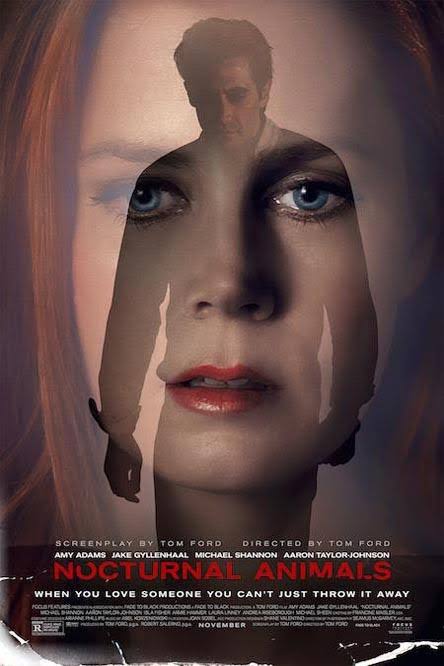Jenny gives Tom Ford's Nocturnal Animals 4 stars
What does a fashion designer do when he wants more challenge? Easy. He makes a film. And he features the world he knows so well, the world of exquisite style where nothing is left unfinished, rough, messy, unburnished – a world where the ugliest things are ironic and even their ugliness is gorgeous.
 We know we are in this world when the
film opens with garish shots of obese naked women twirling and gyrating, every
creased wobble of fat seen in loving close-up. It’s like Lucien Freud’s Benefit
Supervisor come to life in triplicate.
We know we are in this world when the
film opens with garish shots of obese naked women twirling and gyrating, every
creased wobble of fat seen in loving close-up. It’s like Lucien Freud’s Benefit
Supervisor come to life in triplicate.
This turns out to be the latest show by a successful LA gallery owner, Susan, played by Amy Adams, fawned over by hangers on, including a cameo from Michael Sheen in bushy whiskers and a shiny lavender jacket which definitely does not suit him. Nor does Susan’s OTT dark smudgy eye makeup – far, far too much for a pretty and delicate redhead. But the makeup is a mask. Susan is unhappy, you see; she has made the terrible mistake of marrying an idiot, a failing millionaire and serial adulterer rather than staying with the homely Edward, a failing writer. And she no longer believes in her work.
What does a fashion designer do when he wants more challenge? Easy. He makes a film. And he features the world he knows so well, the world of exquisite style where nothing is left unfinished, rough, messy, unburnished – a world where the ugliest things are ironic and even their ugliness is gorgeous.
This turns out to be the latest show by a successful LA gallery owner, Susan, played by Amy Adams, fawned over by hangers on, including a cameo from Michael Sheen in bushy whiskers and a shiny lavender jacket which definitely does not suit him. Nor does Susan’s OTT dark smudgy eye makeup – far, far too much for a pretty and delicate redhead. But the makeup is a mask. Susan is unhappy, you see; she has made the terrible mistake of marrying an idiot, a failing millionaire and serial adulterer rather than staying with the homely Edward, a failing writer. And she no longer believes in her work.
Edward sends her a proof copy of his
novel. She reads it alone, overlooking the city in her dark, exquisite LA
apartment where again nothing is unconsidered, right down to the sculptures,
pictures and polished concrete bath. Looking nervously on to the terrace where
she thinks she sees some small, troubling movement, she embarks on a journey, a
film within the film, where we see what happens in Edward’s book.
Act 1 is the best part of the movie,
unbearably tense. Edward’s alter ego, Tony, played brilliantly, like Edward
himself, by Jake Gyllenhaal, sets off on an all night drive with his wife and
daughter through the Texan desert. There they encounter three terrible rednecks
who lure them to tragedy. If I had had the prescience to take a cushion with me
to the cinema I would have hidden behind it for most of this part. So the film within
the film is a kind of revenger’s tragedy: Edward is telling Susan what he
wishes had happened to her even though they have had no contact for twenty
years. She sees it as her punishment for living an empty life.
The movie is full of cartoon
characters: the smarmy good looking millionaire, the gallery underling in
hideously fashionable clothing who is more entranced by the app on her phone
than by the baby it is monitoring, the brilliant Michael Shannon as the
drawling Texan lawman never without his Stetson, who cares nothing for the
rules because he knows he is dying from lung cancer; Laura Linney playing a full-on
caricature of the DOR Mommy.
The film left me thrilled, intrigued
and ultimately puzzled. Perhaps it is best seen as American Noir where like the
entire noir genre it deals with the corrupting impact of too much money and of
dealing in a life full of superficialities, plus existential angst and the
punishment of random violence. The best noir films are, like this one, beautifully
composed in every glossy frame. Even the violence is beautiful. The characters
are alone, either actually or psychologically isolated. Again as in most noir
films and novels, there is a pervading anxiety about the sexual power of women
and about what it means to be a man: is Tony/Edward ‘weak’ as Susan’s mother
scornfully judges or is he the gentle, artistic soul who first attracted Susan?
That the director intends us to take some message from the film can’t be in doubt, but what message? I still don’t know, but when I came home to my quiet apartment overlooking the city I carefully double locked the doors and peered nervously on to the terrace. My cat, an excellent alerter to danger, assured me that all was well, but I wasn’t convinced.
That the director intends us to take some message from the film can’t be in doubt, but what message? I still don’t know, but when I came home to my quiet apartment overlooking the city I carefully double locked the doors and peered nervously on to the terrace. My cat, an excellent alerter to danger, assured me that all was well, but I wasn’t convinced.
No comments:
Post a Comment